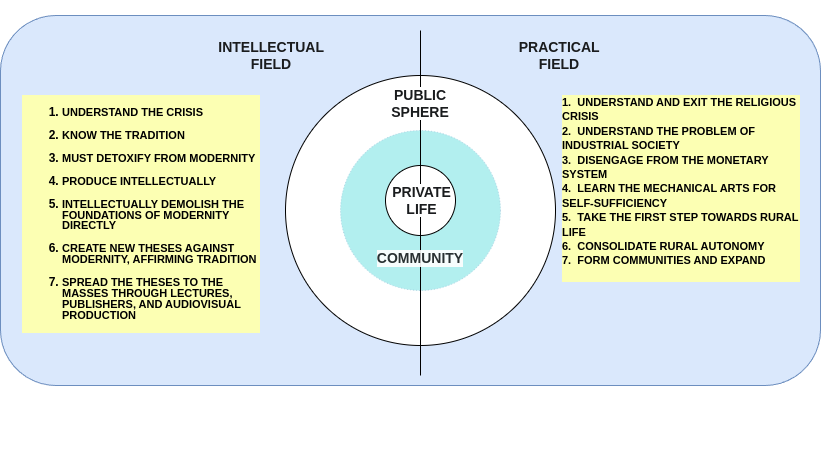THE PATHS TO RESTORATION: A TRADITIONAL RECONSTRUCTION PLAN
Once the temporal and spiritual problems of modernity are diagnosed, the question of how these issues will be resolved naturally arises in the Catholic consciousness. This is a common doubt, which frequently troubles the spirit of the faithful and, therefore, demands a clear and satisfactory answer.
The beginning of the Restoration process will depend on raising individual consciousness through the systematic exposition of tradition in opposition to modernity. Spirits will be enlightened as the effects of the revolution become evident in their lives. When men recognize the moral, social, spiritual, and professional shackles that imprison them, they will be more inclined to react. This reaction will occur on both the intellectual and material planes.
In the intellectual sphere, the effort is divided between understanding and transmitting. The work of understanding falls to the intellectual agents, who must deepen their understanding of Restoration itself and its relationship with the revolution. Transmission, on the other hand, seeks to disseminate, in an accessible manner, the conclusions reached by the movement's core, expanding its reach among the masses.
The material reaction, in turn, can be schematically divided between the public and private spheres. The private sphere, directly under the control of each individual, precedes the public sphere, which ranges from small communities to the global stage. Thus, private reaction is the starting point and a prerequisite for any public action.
Large-scale mobilization will only be possible when individuals are consistently accustomed to reacting in their private lives. This reaction begins with the boycott, understood as the refusal to cooperate with the mechanisms of the revolution. Given the impossibility of demolishing the modern state, what remains is to nullify its interference in private life. Removing the interference of modernity implies working to enable an existence grounded in Catholic tradition and free from revolutionary influence. This goal requires an active pursuit of self-sufficiency, because, without it, any broader reaction will be unfeasible.
Although obvious, it is important to emphasize that the future of the restorationist movement lies in the rural environment, not the urban one.
Those who lack aptitude for intellectual combat should dedicate themselves to material Restoration, which will only be achieved through autonomy and self-sustainability. Modernity depends on the continuous disintegration of families and communities; therefore, the restorationist movement must concentrate efforts on the union and association of its members. While some will achieve self-sufficiency easily, others will need support — which imposes on the more affluent the moral duty to cooperate with those in need.
As inferred from the image after the table, everyone needs to become aware of the two arts: the liberal art (intellectual) and the mechanical art (practical).
Restoration is a daily struggle, rooted in true Catholic traditionalism, which occurs through intellectual and material pathways. In the intellectual sphere, it demands a continuous effort to systematically understand the various aspects of the revolution and present the results to the public in a clear and accessible manner. On the material plane, it requires, firstly, the elimination of revolutionary influence in private life and, secondly, the construction of solid communities that enable the movement's expansion.
THE LIBERAL AND MECHANICAL ARTS AS A RESTORATIONIST STRATEGY
|
INTELLECTUAL LIFE |
PRACTICAL LIFE |
|
1. UNDERSTAND THE CRISIS |
1. UNDERSTAND AND EXIT THE RELIGIOUS CRISIS |
|
2. KNOW THE TRADITION |
2. UNDERSTAND THE PROBLEM OF INDUSTRIAL SOCIETY |
|
3. DETOXIFY FROM MODERNITY |
3. DISENGAGE FROM THE MONETARY SYSTEM |
|
4. PRODUCE INTELLECTUALLY |
4. LEARN THE MECHANICAL ARTS AIMING FOR SELF-SUFFICIENCY |
|
5. INTELLECTUALLY DEMOLISH THE FOUNDATIONS OF MODERNITY |
5. TAKE THE FIRST STEP TOWARDS RURAL LIFE |
|
6. CREATE NEW THESES AGAINST MODERNITY AFFIRMING TRADITION |
6. CONSOLIDATE RURAL AUTONOMY |
|
7. EXPAND THE THESES TO THE MASSES THROUGH CLASSES, BOOKS, AND AUDIOVISUAL PRODUCTIONS |
7. FORM COMMUNITIES AND EXPAND THE MOVEMENT |

